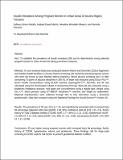| dc.description.abstract | To establish the prevalence of insulin resistance (IR) and its determinants among selected pregnant women in urban Arusha for taking preventive measures. A cross-sectional study was conducted between March and December 2018 at Ngarenaro and Kaloleni health facilities in Arusha District involving 230 randomly selected pregnant women who were not known to have diabetes before pregnancy. Blood glucose at fasting and 2 hr after consuming 75 grams of glucose dissolved in 300 mL of water was measured using Gluco-Plus™, serum insulin concentrations using ELISA machine (Synergy/HTX™; BioTek), and IR was calculated using the Homeostasis Model of Assessment formula. Body fat was measured using a bioelectric impedance analyzer, mid-upper arm circumference using a regular tape, weight using SECA™, blood pressure using GT-868UF Geratherm™ machine, and height by stadiometer. Maternal characteristics were collected through face to face interviews using a structured questionnaire. Data were analyzed using the Statistical Package for Social Science™ Version 20. The prevalence of IR was 21% ( = 49) and significantly associated with increased body fat percentage (adjusted odds ratio [AOR]: 1.68, 95% confidence interval [CI]: 1.01-2.5), family history of Type 2 diabetes mellitus (T2DM; AOR: 2.77, 95% CI: 1.21-6.33), hypertension (AOR: 2.5, 95% CI: 1.12-5.6), edema (AOR: 3.01, 95% CI: 1.31-6.96), and proteinuria (AOR: 3.44, 95% CI: 1.11-10.69). IR was higher among pregnant women with increased body fat percentage, family history of T2DM, hypertension, edema, and proteinuria. These findings call for large-scale screening to further explore risk factors to prevent gestational diabetes mellitus. | en_US |

